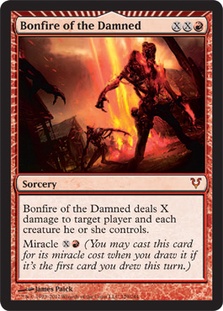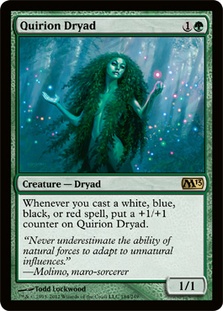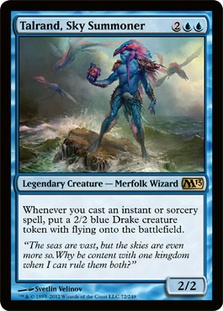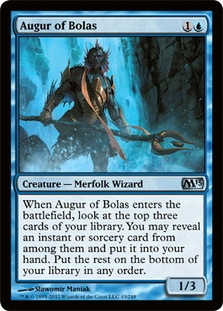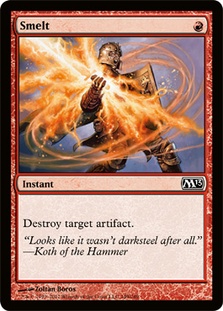Last week, I featured a U/G Delver decklist in a playtest video I did with fellow writer and player Brian Braun-Duin (BBD). We got a lot of great feedback on the video, and even more people have been clamoring for an "updated" list of the U/G Delver deck, so today I’m going to focus on that archetype and some changes I’ve been working on. I think the deck is incredibly powerful, and I’m trying to turn it into an unstoppable machine before the Standard PTQ season runs out!
I think that older versions of U/W Delver utilized Geist of Saint Traft to do too much of the dirty work. Unfortunately, we’re in such a hostile environment that even control decks are packing Phantasmal Image just to deal with it, and every Birthing Pod deck and Zombie deck just makes Geist of Saint Traft virtually irrelevant. Sometimes you still get your nut draw with a million Vapor Snags, but that just isn’t the world where I want to be living. I want my threats to hit hard and be more resilient to the answers people are currently playing.
After toying around with the U/G Delver list from the playtest video, I came to some conclusions. I knew that I needed a way to make Quirion Dryad a bigger threat. That meant adding something like Spectral Flight to the deck or taking a different approach by adding another color. Gut Shot was pretty sweet but really underperformed against Zombies. Adding red to the deck would give us access to a particularly sweet answer in Pillar of Flame, but it also would give us a way to clear the opponent’s side of the board so that our Quirion Dryads could rumble on through unopposed.
With a bit of tinkering, here is my current list that I’m pretty happy with.
Creatures (14)
Lands (21)
Spells (25)
- 2 Mana Leak
- 4 Ponder
- 1 Mutagenic Growth
- 2 Mental Misstep
- 4 Gitaxian Probe
- 3 Vapor Snag
- 1 Dismember
- 1 Gut Shot
- 1 Thought Scour
- 3 Bonfire of the Damned
- 3 Pillar of Flame
Sideboard

As you can see, there are some obvious similarities in this list and the list that I played in our playtesting video last week, which can be found here.
I recommend checking out that video for some in-depth games and commentary. While the newer version of the deck is a bit different, there is a lot of shared theory behind the deck and card choices. I highly recommend watching it if you have time.
So what makes this version of Delver better than the ones with Geist of Saint Traft? Well, I honestly hate Geist of Saint Traft at the moment. I haven’t attacked with him much lately because nearly every opponent has Phantasmal Image or some other very cheap answer to it. I understand that Quirion Dryad is a bit more vulnerable to traditional removal since it doesn’t have hexproof, but there is a lot to be said about the difference between two and three mana. Additionally, the Phantasmal Images aren’t that good against this version of Delver.
At some point, I may end up reverting back to Geist of Saint Traft due to shifts in the metagame or changes in the cards people are playing against me, but I think Quirion Dryad is just absurd right now, especially when combined with Bonfire of the Damned!
Today I’ll go over the deck card by card to give you a bit of insight as to why I’m playing certain cards and how they interact with the opponent.
The Meat
First up, I’ll go over the creature suite and why it’s the most important part of the overall strategy. If you’ll notice, all of the creatures greatly benefit from filling your deck with instants and sorceries, and we have a lot of them! This is the most important aspect of the creature suite, since all of your creatures become bigger and better with a high spell count. Additionally, picking the correct spell suite to support your creatures is very important.
Delver of Secrets
A lot of people think that Delver gives you free wins. A lot of people are right, but that isn’t the only reason to play Delver. It is an efficient threat that benefits those who build their deck around instants and sorceries. If you notice, all of our non-creature cards are instants and sorceries, leaving us with a cool 25 natural ways to flip Delver of Secrets.
While Delver hasn’t always been an include into these U/x Snapcaster Mage decks, I think any version that hopes to win a tournament this weekend should begin with four copies. The sheer pressure you can put on your opponent if Delver is left unmolested is just uncanny. After a while, all I can really think is, "Why don’t people do more to stop him?"
After all, how good can Merfolk of the Pearl Trident be? As it turns out, pretty damned good.
Snapcaster Mage
I consider Snapcaster Mage to be the heart of the deck and the card you want to draw the most of in just about every game you play. Without Snapcaster Mage, a lot of the synergy you are trying to build upon just wouldn’t be possible. The card and tempo advantage you gain from drawing Snapcaster Mage is unparalleled in Standard, giving you a threat while also providing you with spell redundancy. Your spells are all very good, but some are outrageously situational (such as Mutagenic Growth). Snapcaster Mage allows you to recast whichever one of those spells is better in your current situation, allowing you to dig out of holes that were previously thought impossible.
Sure, sometimes you’ll draw two or three Snapcaster Mages along with some Delvers and get "creature flooded," but once you draw a Ponder, everything changes. Your draw becomes one of the best it could possibly be. You begin churning through spells at lightning speed, providing pressure all the while. Alongside removal, it can even be difficult for other creature decks to keep up with you! The first time you use Snapcaster Mage to rebuy Pillar of Flame on a Geralf’s Messenger, you’ll understand exactly what I mean.
Quirion Dryad
As I discussed in the video, Quirion Dryad is one of my favorite creatures of all time. It only feels natural for the Dryad to make its way into Delver since there is so much synergy to be had! You already have incentive to fill your deck with cheap spells in order to make Snapcaster Mage and Delver of Secrets better, but Quirion Dryad just feels like a natural fit to the shell. Alongside Vapor Snag, Pillar of Flame, and Bonfire of the Damned, you shouldn’t have much trouble removing all of your opponent’s creatures from play so that you can kill them faster.
Talrand, Sky Summoner
The biggest argument for Talrand is that, in a jam, he is the only card that can provide you with a way to regain board dominance. When your opponent isn’t playing sweeper effects, Talrand will easily flood the board with a flurry of 2/2 flying Drakes. Unfortunately, Bonfire of the Damned is still a card that your opponents will play, and I’m just not sure how good it will be in those particular matchups.
Talrand can completely dominate an opponent given the right set of circumstances, but I think you want your threats to be cheap. Giving your opponent a really juicy Bonfire target on turn 5 is just asking for it. With that said, it is a great card against any deck that doesn’t play Bonfire.
Phantasmal Image
Since this is still your best answer to Geist of Saint Traft, Phantasmal Image is a must. I want to try a few in the maindeck, but I just don’t think it is good enough in other matchups. Sure, you can copy a Hunter master of the Fells or Blade Splicer, but you don’t have the powerful recursion like Restoration Angel that those decks do. You can’t really hope to match them in that regard, so you just have to go over the top. Phantasmal Image mostly comes in against U/W Delver to combat Geist of Saint Traft, but it has its uses in other matchups as well.
Exclusion of Augur of Bolas
Without equipment, I don’t think Augur of Bolas is very good. With that said, I think that it deserves to be tested extensively. Any creature that can effectively "draw a card" for a paltry two mana and has a reasonable body is not something to take lightly. It may not hit very hard, but it can act as a way to facilitate the rest of the strategy. Court Hussar and Sea Gate Oracle are fair comparisons, but neither of those saw much play in aggressive decks. To be fair, neither of those existed in a format where Runechanter’s Pike and Swords of Something or Another existed. Neither of them was as cheap as Augur of Bolas, either!
The Potatoes
In this section, I’ll go over the parts that flow around the center of the deck, namely the instants and sorceries. These spells are important for helping the deck run smoothly and making your creatures as powerful as possible.
Gitaxian Probe, Ponder, Thought Scour
These spells are pretty obvious by now. They draw cards, allow for you to grow your Quirion Dryad, and give your Snapcaster Mage a way to draw extra cards. I think Thought Scour is the worst of the three, and that is why I’m not playing very many of them.
Pillar of Flame and Gut Shot
The split here is not accidental. Both are incredibly powerful in certain situations, but they are very different at what they do. Pillar of Flame dominates Zombies and puts them into situations where Snapcaster Mage is absolutely backbreaking. On the other hand, casting Pillar of Flame on the first turn against a deck featuring Birds of Paradise can be difficult. This is where Gut Shot can shine and where Snapcaster Mage can become a Flametongue Kavu of sorts, giving you some card and tempo advantage while you apply pressure
I like having these cards in different situations, but I definitely think that mixing the two is correct. With access to red mana, being able to cast Pillar of Flame over Gut Shot is pretty awesome.
Mana Leak
I’m actually not a huge fan of this card right now, but there are so many matchups where you just need it to stabilize the board. Against control decks, keeping them off Gideon Jura or Day of Judgment can be all the difference. I am starting to hate this card more and more as people adopt Cavern of Souls into virtually every archetype, but I suppose that was the point of Cavern of Souls in the first place! Regardless, it is a necessary evil, and one that I am hesitant to cut without a really good reason.
As always, Mana Leak becomes much better as you apply more pressure. When your opponent has ample time to draw themselves out of their predicament, the value of Mana Leak decreases significantly. When you bottleneck your opponent on time, you will effectively bottleneck them on mana as well.
Mental Misstep
I can make a lot of arguments for Mental Misstep, but I think Gerry Thompson said it best: Rancor. Rancor is a real card in Standard; one you should be very afraid of. When suited up to a Dungrove Elder, it is safe to say that you probably aren’t winning that game unless you can make your Quirion Dryad very big.
On top of this, I think the format is lowering its overall curve. When this happens, Mental Misstep can be a gigantic tempo boost. You are also helping to prevent Vapor Snag from being a potent weapon against you since Quirion Dryad is relatively vulnerable to it. Unfortunately, most Vapor Snags are followed by a Snapcaster Mage, so this "answer" isn’t overly effective.
Vapor Snag and Dismember
These are your primary ways of removing larger creatures from play since most of your removal is rather selective. Bonfire of the Damned can potentially deal with larger threats, but that generally comes much later in the game. You will need answers to Restoration Angel, Titans, and everything in between. Vapor Snag does the trick most of the time, but Dismember can take care of most of those creatures once and for all.
Bonfire of the Damned
For me, this is the biggest draw for playing red. At the moment, I feel as if everyone is trying to move all-in on board stalls, which I hate. Bonfire of the Damned is only growing more and more powerful due to this trend, but it is necessary to exploit weaknesses in a metagame. With cards like Blade Splicer and Huntmaster of the Fells in the format, games can become a huge grind. Pondering into Bonfire of the Damned could be your only out!
While Bonfire of the Damned isn’t always amazing, I do think that drawing it at the right time in a lot of matchups will just win you the game on the spot, and that isn’t something a lot of cards in Standard can boast. Alongside Quirion Dryad, I think that clearing the way of small blockers can be very important, and Bonfire for X=1 will be almost as important for X=2+.
Negate
Negate is an interesting card, but one that becomes more and more powerful as you care less about the creatures the opponent is playing. Dissipate is a decent card, but when every ramp deck and control deck is casting their Titans off Cavern of Souls, your Dissipates look much worse than Negate. Overall, I think that Negate is pretty awesome right now.
Combust
This is one of the best answers to an opposing Delver deck that plays Restoration Angel. Alongside Phantasmal Image for their Geist of Saint Traft, I just want to become the control deck and kill every single creature they play! With so many efficient answers to their threats, I think it will be hard to lose. Just play your spells so that you can maximize value, even if you aren’t playing them with the greatest efficiency.
Ancient Grudge vs. Smelt
I really like Smelt, but I think that the power to flashback Ancient Grudge on its own is pretty awesome. With so many dig spells, you will likely be able to find an Ancient Grudge in the matches where you need it, killing a pair of Birthing Pods or other annoyances. I do like that Smelt only costs one mana, which can mean the world when you’re playing a deck like Delver, but I’m not sure that’s the mentality you need to adopt in those matchups. You need to make sure they don’t keep a Birthing Pod on the table, and Ancient Grudge helps solve that problem for quite a few turns.
The Gravy
The mana base is pretty decent. You will stumble on occasion, but that is the nature of playing so few lands and so many cantrip effects. Evolving Wilds can also be a pain sometimes, but your deck just can’t function properly without it. If you want to be greedy and play more than two colors, then you are probably going to have to play Evolving Wilds. At some point, I think testing a version with just Hinterland Harbor, Sulfur Falls, and Copperline Gorge as dual lands wouldn’t be such a bad idea, but Evolving Wilds acting as a tri-land of sorts is quite good.
Copperline Gorge is pretty absurd in the deck, giving you sources of both red and green early on while coming into play untapped. This will allow you to curve Pillar of Flame into Quirion Dryad, which can be a huge opening in a lot of matchups. I think that the addition of Copperline Gorge to the deck, along with the red splash, will be exactly the boost this deck needed in order to compete against Zombies and Naya Aggro.
The rest of the mana base is pretty self-explanatory. I don’t think you can fit the full set of Hinterland Harbor or Sulfur Falls into the list at the moment, but both feel fine alongside the nine Islands.
…
In closing, I would like to say that I think this deck is incredibly powerful. I will be playing my first PTQ featuring M13 this coming weekend, and it should be a lot of fun! I will likely be playing some form of Delver, and I’ll be doing some more testing this week to finalize my build.
Let me know how your playtesting and tournaments go with the deck, as I would love some feedback on the evolution of the archetype. I really want Quirion Dryad to shine for at least a little while, because I fear its power level will diminish greatly once Phyrexian mana spells rotate out of the format. I appreciate all of the comments and questions I’ve been getting lately. If I don’t respond to every one, I do apologize. Keep them coming, and I will do my best to answer them. And, as always…
Thanks for reading.
strong sad on Magic Online
@strong_sad on Twitter; follow me!

